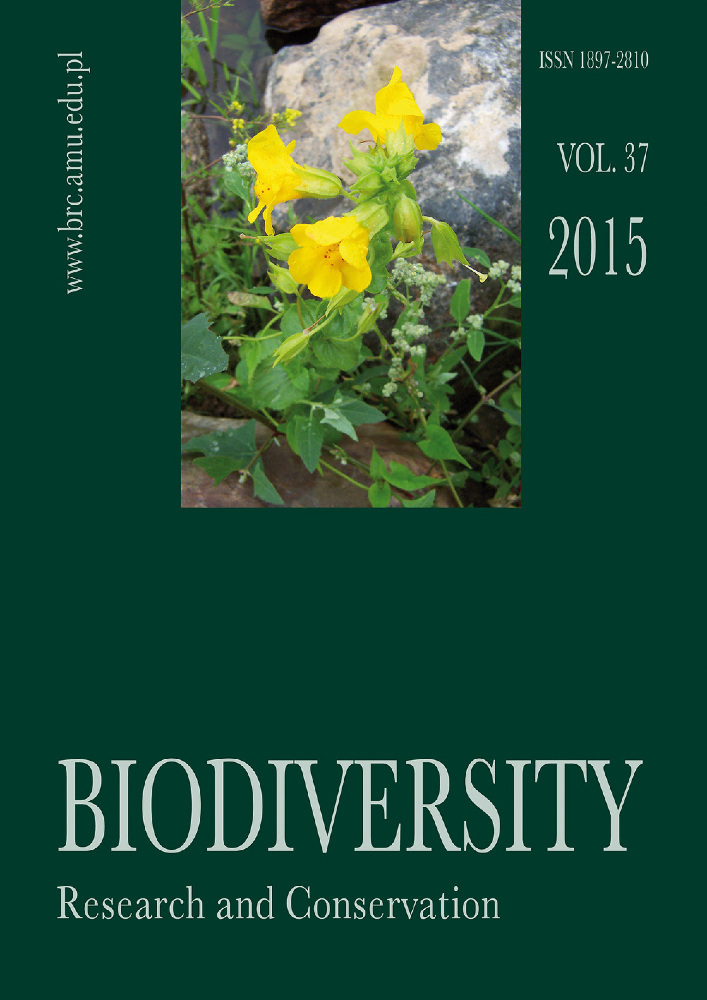Abstract
The paper presents the results of research of plant macrofossils from the grain deposit deriving from the 18th/19th centuries. The analysed material included 24760 diaspores representing 73 taxa. The majority were cultivated cereal crop species, and there was also abundance of accompanying segetal weed species. About 95% of the gathered crop material was Secale cereale. Another important crop was Hordeum vulgare and there were also some remains of Avena sativa, Triticum aestivum, Fagopyrum esculentum. Cannabis sativa and Linum usitatissimum were found as well. Weeds competing with these crops were, among others, the following species: Agrostemma githago, Raphanus raphanistrum, Apera spica-venti, Bromus secalinus, Centaurea cyanus, Spergula arvensis, Thlaspi arvense, Viola arvensis/tricolor, Fallopia convolvulus, Polygonum persicaria, Mentha arvensis, Anthemis arvensis, Papaver rhoeas, Rumex acetosella, Scleranthus annuus, Aphanes arvensis, Setaria pumila, Setaria viridis/verticilata. Extremely large presence of wild plant diaspores in the material allowed conducting economic and environmental interpretations. Reconstruction methods applied, used primarily in the case of macroremains from granaries, were fully applicable to the analysed plant residues. Weed species composition in the analysed material showed that they were mostly typical for the main winter crop. Some amount of species typical for other habitats were also found and they probably came from the near-by rye field. The presence of perennial diaspores indicated that the field was probably set aside
References
Alsleben A. 1995. Nutzpflanzen aus dem mittelalterlichen Wolin. Zwei ausgewählte Gruppen: Getreide Und Lein. Offa 52: 185-217.
Badura M. 1999. Szczątki gryki (Fagopyrum esculentum Moench) ze średniowiecznego Kołobrzegu. Polish Botanical Studies, Guidebook 23: 219-231.
Badura M. 2011. Rośliny użytkowe w dawnym Gdańsku. Studium archeobotaniczne. 337 pp. Wyd. Uniwersytetu Gdańskiego, Gdańsk.
Degórski M. 2005. Gleba jako indykator zmian w środowisku przyrodniczym. Przegląd Geograficzny 77(1): 337-354.
Goslar T. 2013. Pomorzany - Raport z wykonania datowania C-14 - jama 318. In: T. Poklewski-Koziełł T. (ed.).
Joanna Koszałka & Joanna Ewa Strzelczyk Archaeobotanical reconstructions of field habitats and crops... Centrum włości szlacheckiej w Pomorzanach i Pomorzankach pod Kutnem od 1375 do 1810 roku. CD-room, Łódź.
Herse J. (ed.). 1976. Szczegółowa uprawa roślin. 609 pp. PWN, Warszawa.
Jackowiak B. 1993. Atlas of distribution of vascular plants in Poznań. Publications of the Department of Plant Taxonomy of the Adam Mickiewicz University in Poznań 3: 1-409.
Kosina R. 1977. Wrocławskie spichrze z XI w. - przyczynek do badań nad gospodarką regionu. Kwartalnik HistoriiKultury Materialnej 25: 257-267.
Koszałka J. & Strzelczyk J. E. 2006. The grain storehouse from the early medieval stronghold at Józefów near Kalisz. Fasciculi Archaeologiae Historicae 18: 9-18.
Köhler P. 2013. Odpowiedź Romana Gutwińskiego (1860-1932) na ankietę etnobotaniczną Józefa Rostafińskiego (1850-1928) ogłoszoną w 1883 r. Etnobiologia Polska 3: 47-53.
Lityńska-Zając M. 2005. Chwasty w uprawach roślinnych w pradziejach i wczesnym średniowieczu. 444 pp. Wyd. Instytutu Archeologii i Etnologii PAN, Kraków.
Lityńska-Zając M. & Wasylikowa K. 2005. Przewodnik do badań archeobotanicznych. In: J. B. Faliński (ed.). Vademecum Geobotanicum, 5, 566 pp. Sorus, Poznań.
Maik 2013. Zabytki nieruchome. In: T. Poklewski-Koziełł (ed.). Archeologiczne zeszyty autostradowe Instytutu Archeologii i Etnologii PAN. Centrum włości szlacheckiej w Pomorzanach i Pomorzankach pod Kutnem od 1375 do 1810 roku. 14: 43-50. Łódź.
Matuszkiewicz W. 2001. Przewodnik do oznaczania zbiorowisk roślinnych Polski. In: J. B. Faliński (ed.). Vademecum Geobotanicum 3, 537 pp. Wyd. Nauk. PWN, Warszawa.
Mazurek J. & Ruszkows ki M. 1976. Żyto. In. J. Herse (ed.). Szczegółowa uprawa roślin, pp. 78-98. PWN, Warszawa.
Mirek Z., Piękoś-Mirkowa H., Zając A. & Zając M. 2002. Flowering plants and pteridophytes of Poland. A checklist. In: Z. Mirek (ed.). Biodiversity of Poland, 1, 442 pp. W. Szafer Institute of Botany, Polish Academy of Sciences, Kraków.
Ohnish i O. 2004. Origin of Cultivated Buckwheat. Proceedings of the 9th International Symposium on Buckwheat, pp. 16-21.
Ralski E. 1957. Szczegółowa uprawa roślin. 735 pp. PWRiL, Warszawa. Biodiv. Res. Conserv. 37: 75-81, 2015
Strzelczyk J. 2003. Proso zwyczajne (Panicum miliaceum L.) we wczesnym średniowieczu Wielkopolski Prace Zakładu Biogeografii i Paleoekologii UAM w Poznaniu, 2: 1-36. Bogucki Wyd. Nauk., Poznań.
Topolski J. 1964. Polowa produkcja roślinna. In: B. Baranows ki & J. Topolski (eds.). Zarys historii gospodarstwa wiejskiego w Polsce. Okres gospodarki folwarczno-pańszczyźnianej (od drugiej połowy XV do XVIII w.). 2(4): 146-178. Warszawa.
Tymrakiewicz W. 1962. Atlas chwastów. 367 pp. PWRiL, Warszawa.
Wasylikowa K. 1978. Plants remains from Early and Late Medieval time found in the Wawel Hill in Cracov. Acta Palaeobotanica 19(2): 1-198.
Wasylikowa K. 1983. Antropogeniczne zmiany roślinności w holocenie. In: J. K. Kozłowski & S. K. Kozłowski (eds.). Człowiek i środowisko w pradziejach, pp. 53-72. Warszawa.
Zając E. U. & Zając A. 1975. Lista archeofitów występujących w Polsce. Zeszyty Naukowe UJ, 395, Prace Botaniczne 3: 7-16.
Zapaśnik T. 2013. Obraz geomorfologiczny. In: T.
Poklewski-Koziełł (ed.). Archeologiczne zeszyty autostradowe Instytutu Archeologii i Etnologii PAN. Centrum włości szlacheckiej w Pomorzanach i Pomorzankach pod Kutnem od 1375 do 1810 roku. 14: 17-23. Łódź.
Zarzycki K., Trzcińska-Tacik H., Różański W., Szeląg Z., Wołek J. & Korzeniak U. 2002. Ecological indicator values of vascular plants of Poland. In: Z. Mirek (ed.). Biodiversity of Poland, 2, 183 pp. W. Szafer Institute of Botany, Polish Academy of Sciences, Kraków.




